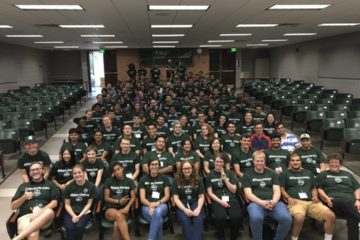We found 304 results that contain "it"
Posted on: #iteachmsu

DISCIPLINARY CONTENT
Opportunities to Respond
In creating peer-mediated activities, the teacher may need to choose students whoseskill levels complement each other. Students with and without attention difficulties andimpulsivity should be considered for peer partnerships.
Authored by:
Piffner

Posted on: #iteachmsu


Opportunities to Respond
In creating peer-mediated activities, the teacher may need to choos...
Authored by:
DISCIPLINARY CONTENT
Tuesday, Feb 8, 2022
Posted on: #iteachmsu

NAVIGATING CONTEXT
Creativity to Support Student Learning in a Digital Learning Environment
Method Components
What are the 4Cs?
The 4Cs for 21st century learning are Creativity, Critical Thinking, Communication, and Collaboration. They are part of the framework for 21st Century Learning and are designed to support student learning in today’s world and are skills they can use in college and career.
What is creativity (and what is it not)?
Stein (1953) defined creativity as “a novel work that is accepted as tenable or useful or satisfying by a group in some point in time” (p. 311). While many other definitions have emerged since 1953, many reiterate the idea of it being “novel” and “useful.” In the classroom, this means giving students freedom to create something new (novel) to address a problem or a need (useful). Construction of something new or innovative is a key component of creativity - creativity does not mean letting students color or copy an existing model, rather it means letting students create something new that can apply to a given, often teacher-created, context.
Example strategies that use technology to support creativity in the classroom:
Digital Storytelling:
Storybird: Storybird gathers images and invites students to turn those images into original stories.
Google docs are a simple tool that can allow your students to put their ideas to paper in an easy to share format.
Story builder
My Simple Show
Powtoon
Developing and Building Prototypes:
Google drawing or Tinkercad are great resources for designing digital prototypes
If you’re lucky enough to have access to a 3D printer see if your students can print their designs. If not, have them use the digital prototypes to mock up their own prototypes using other materials.
Appsmashing
(see https://www.smore.com/9g1x-elementary-ipads)
App smashing occurs when learners use the functionality from more than one tool to build something with greater functionality. App smashing requires more planning, experimentation and it can foster creativity.
For more ideas and examples, see the resources below.
Supporting Rationale and Research
Beghetto, R. A. (2013). Killing ideas softly? The promises and perils of creativity in the classroom. Charlotte, NC: Information Age Press.
Kaufman, J. C., & Beghetto, R. A. (2009). Beyond big and little: The Four C Model of Creativity. Review of General Psychology, 13, 1-2. doi:10.1037/a0013688
Resources
What We Know About Creativity (P21, Part of the 4Cs Research Series)https://www.scribd.com/document/360194838/p21-4cs-research-brief-series-creativityThis research brief provides an overview of creativity, the research on it, and some ideas for teachers to use for implementation in their classrooms.
Creativity in the Digital Classroom (21st Century Ed Tech)https://21centuryedtech.wordpress.com/2013/01/14/part-1-creativity-in-the-digital-classroom-over-40-resources-are-they-in-your-school/This blog lists 40 resources and tools you can use to support students’ creativity in your digital classroom. This is the first of a four part series so explore other posts for additional ideas.
Digital Storytelling Activitieshttps://sites.google.com/site/richardbyrnepdsite/digital-storytelling/digital-storytelling-challenge-activitiesRichard Byrne created this Google Site full of resources for educators interested in digital storytelling. There are a variety of types of digital storytelling activities, each with a beginner, intermediate, and advanced version based on your comfort with technology.
Introduction to the 4Cs (Common Sense Media)https://www.commonsense.org/videos/introduction-to-the-4-csThis brief video provides an easy to understand overview of the 4Cs model.
What are the 4Cs?
The 4Cs for 21st century learning are Creativity, Critical Thinking, Communication, and Collaboration. They are part of the framework for 21st Century Learning and are designed to support student learning in today’s world and are skills they can use in college and career.
What is creativity (and what is it not)?
Stein (1953) defined creativity as “a novel work that is accepted as tenable or useful or satisfying by a group in some point in time” (p. 311). While many other definitions have emerged since 1953, many reiterate the idea of it being “novel” and “useful.” In the classroom, this means giving students freedom to create something new (novel) to address a problem or a need (useful). Construction of something new or innovative is a key component of creativity - creativity does not mean letting students color or copy an existing model, rather it means letting students create something new that can apply to a given, often teacher-created, context.
Example strategies that use technology to support creativity in the classroom:
Digital Storytelling:
Storybird: Storybird gathers images and invites students to turn those images into original stories.
Google docs are a simple tool that can allow your students to put their ideas to paper in an easy to share format.
Story builder
My Simple Show
Powtoon
Developing and Building Prototypes:
Google drawing or Tinkercad are great resources for designing digital prototypes
If you’re lucky enough to have access to a 3D printer see if your students can print their designs. If not, have them use the digital prototypes to mock up their own prototypes using other materials.
Appsmashing
(see https://www.smore.com/9g1x-elementary-ipads)
App smashing occurs when learners use the functionality from more than one tool to build something with greater functionality. App smashing requires more planning, experimentation and it can foster creativity.
For more ideas and examples, see the resources below.
Supporting Rationale and Research
Beghetto, R. A. (2013). Killing ideas softly? The promises and perils of creativity in the classroom. Charlotte, NC: Information Age Press.
Kaufman, J. C., & Beghetto, R. A. (2009). Beyond big and little: The Four C Model of Creativity. Review of General Psychology, 13, 1-2. doi:10.1037/a0013688
Resources
What We Know About Creativity (P21, Part of the 4Cs Research Series)https://www.scribd.com/document/360194838/p21-4cs-research-brief-series-creativityThis research brief provides an overview of creativity, the research on it, and some ideas for teachers to use for implementation in their classrooms.
Creativity in the Digital Classroom (21st Century Ed Tech)https://21centuryedtech.wordpress.com/2013/01/14/part-1-creativity-in-the-digital-classroom-over-40-resources-are-they-in-your-school/This blog lists 40 resources and tools you can use to support students’ creativity in your digital classroom. This is the first of a four part series so explore other posts for additional ideas.
Digital Storytelling Activitieshttps://sites.google.com/site/richardbyrnepdsite/digital-storytelling/digital-storytelling-challenge-activitiesRichard Byrne created this Google Site full of resources for educators interested in digital storytelling. There are a variety of types of digital storytelling activities, each with a beginner, intermediate, and advanced version based on your comfort with technology.
Introduction to the 4Cs (Common Sense Media)https://www.commonsense.org/videos/introduction-to-the-4-csThis brief video provides an easy to understand overview of the 4Cs model.
Posted by:
Rohit 936 shinde

Posted on: #iteachmsu


Creativity to Support Student Learning in a Digital Learning Environment
Method Components
What are the 4Cs?
The 4Cs for 21st century learni...
What are the 4Cs?
The 4Cs for 21st century learni...
Posted by:
NAVIGATING CONTEXT
Thursday, Dec 31, 2020
Posted on: #iteachmsu


new--Management skill...
Management skill
Authored by:
Thursday, Apr 27, 2023
Posted on: #iteachmsu

NAVIGATING CONTEXT
About
Teaching Commons: “an emergent conceptual space for exchange and communityamong faculty, students, and all others committed to learning as an essential activity of life in contemporary democratic society”(Huber and Hutchings, 2005, p.1)
What Is the #iteachmsu Commons? You teach MSU. We, the Academic Advancement Network, The Graduate School, and The Hub for Innovation in Learning and Technology, believe that a wide educator community (faculty, TAs, ULAs, instructional designers, academic advisors, et al.) makes learning happen across MSU. But, on such a large campus, it can be difficult to fully recognize and leverage this community’s teaching and learning innovations. To address this challenge, the #iteachmsu Commons provides an educator-driven space for sharing teaching resources, connecting across educator networks, and growing teaching practice.#iteachmsu Commons content may be discipline-specific or transdisciplinary, but will always be anchored in teaching competency areas. You will find blog posts, curated playlists, educator learning module pathways, and a campus-wide teaching and learning events calendar. We cultivate this commons across spaces. And through your engagement, we will continue to nurture a culture of teaching and learning across MSU and beyond.
How Do I Contribute to the #iteachmsu Commons? Content is organized by posts, playlists and pathways.Posts: Posts are shorter or longer-form blog postings about teaching practice(s), questions for the educator community, and/or upcoming teaching and learning events. With an MSU email address and free account signup, educators can immediately contribute blog posts and connected media (e.g. handouts, slide decks, class activity prompts, promotional materials). All educators at MSU are welcome to use and contribute to #iteachmsu. And there are no traditional editorial calendars. Suggested models of posts can be found here.Playlists: Playlists are groupings of posts curated by individual educators and the #iteachmsu community. Playlists allow individual educators to tailor their development and community experiences based on teaching competency area, interest, and/or discipline.Pathways: Pathways are groupings of educator learning modules curated by academic and support units for badges and other credentialing.
There are two ways to add your contribution to the space:Contribute existing local resources for posts and pathways: Your unit, college, and/or department might already have educator development resources that could be of use to the wider MSU teaching and learning community. These could be existing blog posts on teaching practice, teaching webinars, and/or open educational resources (e.g classroom assessments, activities). This content will make up part of the posts, playlists, and pathways on this site. Educators can then curate these posts into playlists based on their individual interests. Please make sure to have permission to share this content on a central MSU web space.Contribute new content for posts: A strength of the #iteachmsu Commons is that it immediately allows educators to share teaching resources, questions and events through posts to the entire community. Posts can take a variety of forms and are organized by teaching competency area categories, content tags, date, and popularity. Posts can be submitted by both individual educators and central units for immediate posting but must adhere to #iteachmsu Commons community guidelines.Posts could be:About your teaching practice(s): You discuss and/or reflect on the practices you’re using in your teaching. In addition to talking about your ideas, successes, and challenges, we hope you also provide the teaching materials you used (sharing the assignment, slidedeck, rubric, etc.)Responses to teaching ideas across the web or social media: You share your thoughts about teaching ideas they engage with from other media across the web (e.g. blog posts, social media posts, etc.).Cross-posts from other teaching-related blogs that might be useful for the #iteachmsu community: You cross-post content from other teaching-related blogs they feel might be useful to the #iteachmsu community.About teaching-related events: You share upcoming teaching related events as well as their thoughts about ideas they engage with events at MSU and beyond (e.g. workshops, conferences, etc.). If these events help you think in new ways about your practice, share them with the #iteachmsu community.Questions for our community: You pose questions via posts to the larger community to get ideas for their practice and connect with others considering similar questions.What Are the #iteachmsu Commons Policies?Part of the mission of the #iteachmsu Commons is to provide space for sharing, reflecting, and learning for all educators on our campus wherever they are in their teaching development. The commons is designed to encourage these types of interactions and reflect policies outlined by the MSU Faculty Senate. We maintain the right to remove any post that violates guidelines as outlined here and by MSU. To maintain a useful and safer commons, we ask that you:Follow the MSU Guidelines for Social Media.Engage across the #iteachmsu commons in a civil and respectful manner. Content may be moderated in accordance with the MSU Guidelines for Social Media.Do not share private or confidential information via shared content on the #iteachmsu Commons.Content posted on the #iteachmsu Commons is licensed under a Creative Commons Attribution-NonCommercial-ShareAlike 4.0 International license. Learn more about this licensing here. Posted comments, images, etc. on the #iteachmsu Commons do not necessarily represent the views of Michigan State University or the #iteachmsu Commons Team. Links to external, non-#iteachmsu Commons content do not constitute official endorsement by, or necessarily represent the views of, the #iteachmsu Commons or Michigan State University.What if I Have #iteachmsu Commons Questions and/or Feedback?If you have any concerns about #iteachmsu Commons content, please email us at iteach@msu.edu. We welcome all feedback and thank you for your help in promoting a safer, vibrant and respectful community.
What Is the #iteachmsu Commons? You teach MSU. We, the Academic Advancement Network, The Graduate School, and The Hub for Innovation in Learning and Technology, believe that a wide educator community (faculty, TAs, ULAs, instructional designers, academic advisors, et al.) makes learning happen across MSU. But, on such a large campus, it can be difficult to fully recognize and leverage this community’s teaching and learning innovations. To address this challenge, the #iteachmsu Commons provides an educator-driven space for sharing teaching resources, connecting across educator networks, and growing teaching practice.#iteachmsu Commons content may be discipline-specific or transdisciplinary, but will always be anchored in teaching competency areas. You will find blog posts, curated playlists, educator learning module pathways, and a campus-wide teaching and learning events calendar. We cultivate this commons across spaces. And through your engagement, we will continue to nurture a culture of teaching and learning across MSU and beyond.
How Do I Contribute to the #iteachmsu Commons? Content is organized by posts, playlists and pathways.Posts: Posts are shorter or longer-form blog postings about teaching practice(s), questions for the educator community, and/or upcoming teaching and learning events. With an MSU email address and free account signup, educators can immediately contribute blog posts and connected media (e.g. handouts, slide decks, class activity prompts, promotional materials). All educators at MSU are welcome to use and contribute to #iteachmsu. And there are no traditional editorial calendars. Suggested models of posts can be found here.Playlists: Playlists are groupings of posts curated by individual educators and the #iteachmsu community. Playlists allow individual educators to tailor their development and community experiences based on teaching competency area, interest, and/or discipline.Pathways: Pathways are groupings of educator learning modules curated by academic and support units for badges and other credentialing.
There are two ways to add your contribution to the space:Contribute existing local resources for posts and pathways: Your unit, college, and/or department might already have educator development resources that could be of use to the wider MSU teaching and learning community. These could be existing blog posts on teaching practice, teaching webinars, and/or open educational resources (e.g classroom assessments, activities). This content will make up part of the posts, playlists, and pathways on this site. Educators can then curate these posts into playlists based on their individual interests. Please make sure to have permission to share this content on a central MSU web space.Contribute new content for posts: A strength of the #iteachmsu Commons is that it immediately allows educators to share teaching resources, questions and events through posts to the entire community. Posts can take a variety of forms and are organized by teaching competency area categories, content tags, date, and popularity. Posts can be submitted by both individual educators and central units for immediate posting but must adhere to #iteachmsu Commons community guidelines.Posts could be:About your teaching practice(s): You discuss and/or reflect on the practices you’re using in your teaching. In addition to talking about your ideas, successes, and challenges, we hope you also provide the teaching materials you used (sharing the assignment, slidedeck, rubric, etc.)Responses to teaching ideas across the web or social media: You share your thoughts about teaching ideas they engage with from other media across the web (e.g. blog posts, social media posts, etc.).Cross-posts from other teaching-related blogs that might be useful for the #iteachmsu community: You cross-post content from other teaching-related blogs they feel might be useful to the #iteachmsu community.About teaching-related events: You share upcoming teaching related events as well as their thoughts about ideas they engage with events at MSU and beyond (e.g. workshops, conferences, etc.). If these events help you think in new ways about your practice, share them with the #iteachmsu community.Questions for our community: You pose questions via posts to the larger community to get ideas for their practice and connect with others considering similar questions.What Are the #iteachmsu Commons Policies?Part of the mission of the #iteachmsu Commons is to provide space for sharing, reflecting, and learning for all educators on our campus wherever they are in their teaching development. The commons is designed to encourage these types of interactions and reflect policies outlined by the MSU Faculty Senate. We maintain the right to remove any post that violates guidelines as outlined here and by MSU. To maintain a useful and safer commons, we ask that you:Follow the MSU Guidelines for Social Media.Engage across the #iteachmsu commons in a civil and respectful manner. Content may be moderated in accordance with the MSU Guidelines for Social Media.Do not share private or confidential information via shared content on the #iteachmsu Commons.Content posted on the #iteachmsu Commons is licensed under a Creative Commons Attribution-NonCommercial-ShareAlike 4.0 International license. Learn more about this licensing here. Posted comments, images, etc. on the #iteachmsu Commons do not necessarily represent the views of Michigan State University or the #iteachmsu Commons Team. Links to external, non-#iteachmsu Commons content do not constitute official endorsement by, or necessarily represent the views of, the #iteachmsu Commons or Michigan State University.What if I Have #iteachmsu Commons Questions and/or Feedback?If you have any concerns about #iteachmsu Commons content, please email us at iteach@msu.edu. We welcome all feedback and thank you for your help in promoting a safer, vibrant and respectful community.
Authored by:
Admin #iteachmsu

Posted on: #iteachmsu


About
Teaching Commons: “an emergent conceptual space for exchange and co...
Authored by:
NAVIGATING CONTEXT
Thursday, Jun 18, 2020
Posted on: #iteachmsu


Digest
Posted by:
Thursday, Apr 15, 2021
Posted on: #iteachmsu

DISCIPLINARY CONTENT
Jet Airways Crisis.
Jet Airways, the cash-starved Indian carrier, has suspended all operations from Wednesday night after the State Bank of India-led consortium of lenders turned down its request for emergency funds. The airline, founded by Naresh Goyal, was under ₹ 8,000 crore debt and was struggling to stay afloat.
Authored by:
Divya Sawant

Posted on: #iteachmsu


Jet Airways Crisis.
Jet Airways, the cash-starved Indian carrier, has suspended all ope...
Authored by:
DISCIPLINARY CONTENT
Tuesday, Dec 1, 2020
Posted on: #iteachmsu

Learning Units
Before youth can be accepted as important players in school decision making, the concept of student voice must gain acceptance among powerful stakeholders in the school. Using social movement theory as a lens, this article examines the consequences of positioning a student voice effort inside or outside of school walls.
Authored by:
Admin

Posted on: #iteachmsu


Learning Units
Before youth can be accepted as important players in school decisio...
Authored by:
Tuesday, Mar 16, 2021
Posted on: #iteachmsu

DISCIPLINARY CONTENT
Types of Robotic Technology
A simpler, more complete definition of robotic types can be narrowed down to five types: Cartesian, Cylindrical, SCARA, 6-Axis and Delta. Each industrial robot type has specific elements that make them best-suited for different applications. The main differentiators among them are their speed, size and workspace applications. The main differentiators among them are their speed, size and workspace.
Authored by:
Neil Carmen

Posted on: #iteachmsu


Types of Robotic Technology
A simpler, more complete definition of robotic types can be narrowe...
Authored by:
DISCIPLINARY CONTENT
Thursday, Aug 6, 2020


